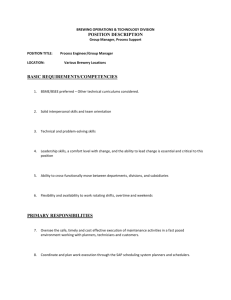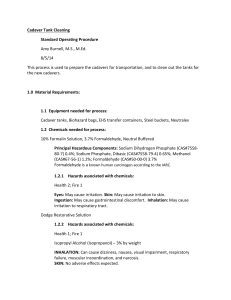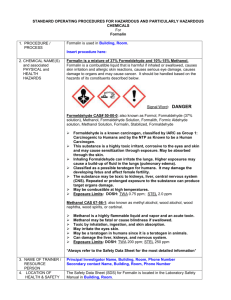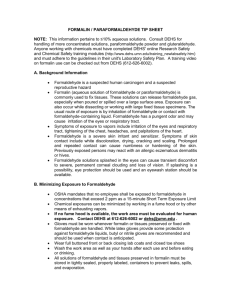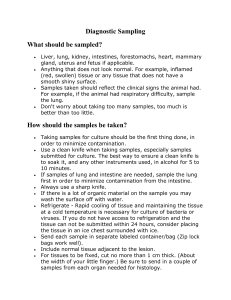effects of chronic exposure of formain on pumonary function test, a
advertisement
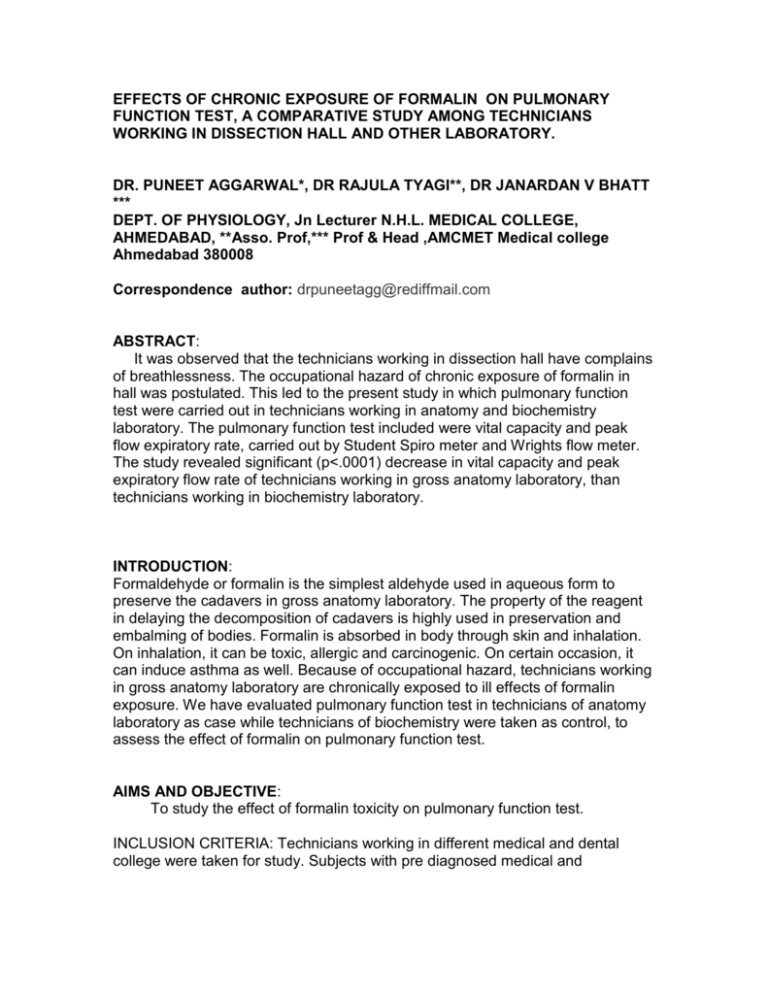
EFFECTS OF CHRONIC EXPOSURE OF FORMALIN ON PULMONARY FUNCTION TEST, A COMPARATIVE STUDY AMONG TECHNICIANS WORKING IN DISSECTION HALL AND OTHER LABORATORY. DR. PUNEET AGGARWAL*, DR RAJULA TYAGI**, DR JANARDAN V BHATT *** DEPT. OF PHYSIOLOGY, Jn Lecturer N.H.L. MEDICAL COLLEGE, AHMEDABAD, **Asso. Prof,*** Prof & Head ,AMCMET Medical college Ahmedabad 380008 Correspondence author: drpuneetagg@rediffmail.com ABSTRACT: It was observed that the technicians working in dissection hall have complains of breathlessness. The occupational hazard of chronic exposure of formalin in hall was postulated. This led to the present study in which pulmonary function test were carried out in technicians working in anatomy and biochemistry laboratory. The pulmonary function test included were vital capacity and peak flow expiratory rate, carried out by Student Spiro meter and Wrights flow meter. The study revealed significant (p<.0001) decrease in vital capacity and peak expiratory flow rate of technicians working in gross anatomy laboratory, than technicians working in biochemistry laboratory. INTRODUCTION: Formaldehyde or formalin is the simplest aldehyde used in aqueous form to preserve the cadavers in gross anatomy laboratory. The property of the reagent in delaying the decomposition of cadavers is highly used in preservation and embalming of bodies. Formalin is absorbed in body through skin and inhalation. On inhalation, it can be toxic, allergic and carcinogenic. On certain occasion, it can induce asthma as well. Because of occupational hazard, technicians working in gross anatomy laboratory are chronically exposed to ill effects of formalin exposure. We have evaluated pulmonary function test in technicians of anatomy laboratory as case while technicians of biochemistry were taken as control, to assess the effect of formalin on pulmonary function test. AIMS AND OBJECTIVE: To study the effect of formalin toxicity on pulmonary function test. INCLUSION CRITERIA: Technicians working in different medical and dental college were taken for study. Subjects with pre diagnosed medical and pulmonary history were excluded. Subjects were selected having an exposure of formalin for at least last six months working min 4 days a week in laboratory. MATERIAL AND METHOD: The present study was carried out among 12 healthy technicians from anatomy laboratory and 15 from biochemistry department aged 30-45 years. Student Spiro Meter was used to measure vital capacity and Wright’s peak flow meter was used to measure PEFR. Verbal consent was taken. For statistical analysis, SSPS software was used. STATISTICAL TESTS: For statistical analysis, SSPS software was used to measure P value: Test was considered significant if P value is less than 0.5 RESULTS: The mean age of subjects was 40 ± 4.5 years. As shown in the Table, the VC and PEFR shows highly significant decrease in subjects working in anatomy laboratory compared to those working in biochemistry laboratory. Table : Pulmonary Function Test Vital capacity (ml) PEFR (ml/sec) Breath holding (in sec) GROUP A Mean ± SD 2455 ± 342.02 270 ± 14.33 36 ± 2 GROUP B Mean ± SD 2988± 378.62 320 ± 18.42 32 ± 1.3 P value,.0001 Significant significant Not significant Group A : technicians of anatomy Group B: Technicians of biochemistry DISCUSSION: Formalin is an irritant gas. The fumes inhaled causes allergic reactions inside lungs. Chronic exposure to formaldehyde has been associated with immunological hypersensitivity as measured by elevated circulating IgG and IgE auto-antibodies to human serum albumin. In addition, a decrease in the proportion of T-cells was observed, indicating altered immunity. The most common symptoms include irritation of the eyes, nose, and throat, along with increased tearing The present study shows that the various lung functions are significantly reduced in who are chronically exposed to the fumes of formalin. These can be attributed to the adverse effect of formalin on respiratory system. Various studies done earlier revealed that FVC decreased in subjects immediately after their first exposure. CONCLUSION: The present study was conducted to evaluate the symptoms caused by formaldehyde fumes that were experienced by the technicians working in the dissection rooms. The probable measures which can be taken will be the lesser concentration of formaldehyde as it will reduce the toxic effects and the other chemicals like surgical spirit, glycerine and carbolic acid will help in maintaining a good preservation of cadavers. As is quoted by BS Mitchell, “reduction in formaldehyde concentration is not deleterious to specimen preservation, but leads to a safer working environment. LIMITATIONS • The study can be extended with more subjects and more pulmonary function test can be evaluated like FEV1, FVC/FEF etc using a computerized spirometer. More analysis can be done if the disease is restrictive or obstructive pattern. The study was convenience based. Study can be further extended for the functions like lung flow volume curves and expiratory flow rates. • The study can be useful for establishing whether formalin results in restrictive or obstructive pulmonary disease. Refrences: 1.Akbar-Khanzadeh F, Mlynek JS. Changes in respiratory function after one and three hours of exposure to formaldehyde in non-smoking subjects. Occup Environ Med 1997;54(5):296–300. 2. Kilburn KH, Warshaw R, Thornton JC. Pulmonary function in histology technicians compared with women from Michigan: effects of chronic low dose formaldehyde on a national sample of women. Br J Ind Med 1986;46(7):468–72. 3. Alexandersson R, Hedenstierna G. Pulmonary function in wood workers exposed to formaldehyde: a prospective study. Arch Environ Health 1986;44(1):5–11. 4. Malaka T, Kodama AM. Respiratory health of plywood workers occupationally exposed to formaldehyde. Arch Environ Health 1990;45(5):288–94. 5. Chia SE, Ong CN, Foo SC, Lee HP. Medical students’ exposure to formaldehyde in a gross anatomy dissection laboratory. J Am Coll Health 1992;41(3):115–9. 6. Wei CN, Harada K, Ohmori S, Wei QJ, Minamoto K, Ueda A. Subjective symptoms of medical students exposed to formaldehyde during a gross anatomy dissection course. Int J Immunopathol Pharmacol 2007;20(2 Suppl 2):23–5. 7. O’Sullivan E, Mitchell BS. An improved composition for embalming fluid to preserve cadavers for anatomy teaching in the United Kingdom. J Anat 1983;182:295–7. 8. Frolich KW, Andersen LM, Knutsen A, Flood PF. Phenoxyethanol as a non-toxic substitute for formaldehyde in long term preservation of human anatomical specimens for dissection and demonstration purposes. Anat Rec 1984;208:271–8. 9. Pabst R. Exposure to formaldehyde in Anatomy: An occupational health hazard? The Anatomical Record 1987;219(2):109–12.
